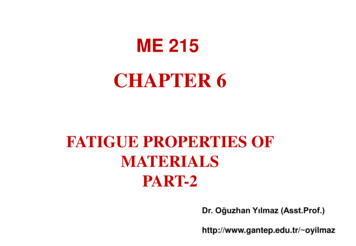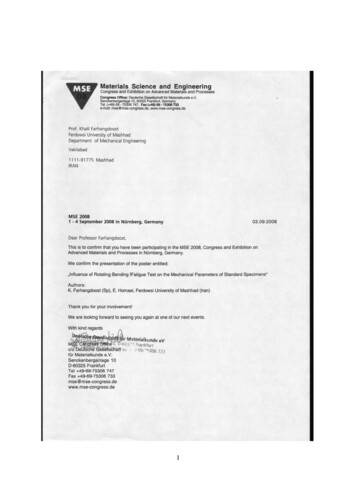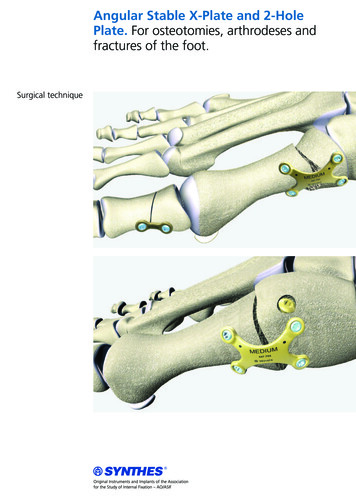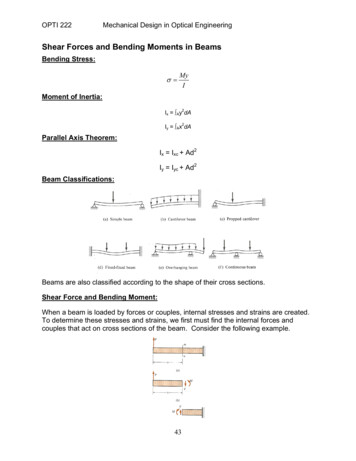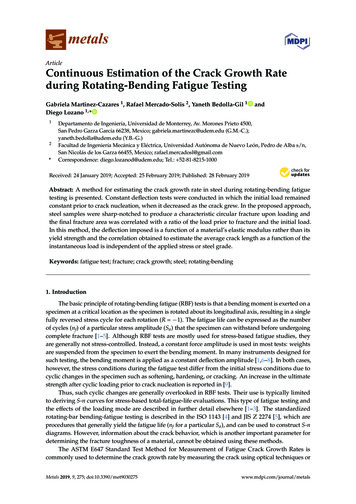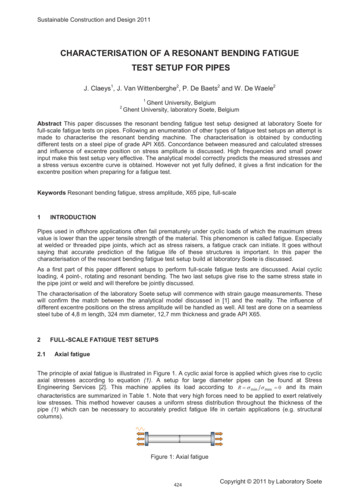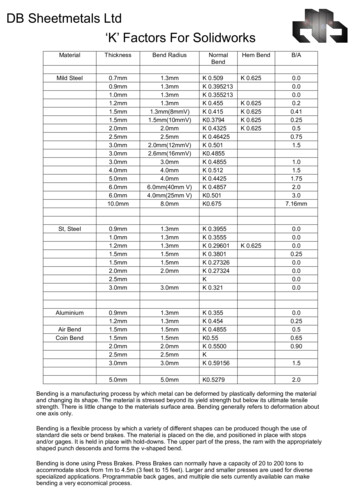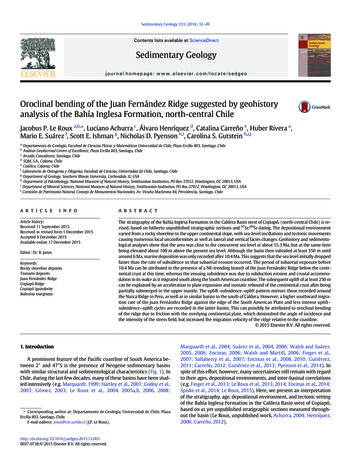
Transcription
Sedimentary Geology 333 (2016) 32–49Contents lists available at ScienceDirectSedimentary Geologyjournal homepage: www.elsevier.com/locate/sedgeoOroclinal bending of the Juan Fernández Ridge suggested by geohistoryanalysis of the Bahía Inglesa Formation, north-central ChileJacobus P. Le Roux a,b,⁎, Luciano Achurra c, Álvaro Henríquez d, Catalina Carreño e, Huber Rivera a,Mario E. Suárez f, Scott E. Ishman g, Nicholas D. Pyenson h,i, Carolina S. Gutstein h,i,jaDepartamento de Geología, Facultad de Ciencias Físicas y Matemáticas Universidad de Chile, Plaza Ercilla 803, Santiago, ChileAndean Geothermal Centre of Excellence, Plaza Ercilla 803, Santiago, ChileArcadis Consultores, Santiago, ChiledSQM, S.A., Calama, ChileeCodelco, Calama, ChilefLaboratorio de Ontogenia y Filogenia, Facultad de Ciencias, Universidad de Chile, Santiago, ChilegDepartment of Geology, Southern Illinois University, Carbondale, IL, USAhDepartment of Paleobiology, National Museum of Natural History, Smithsonian Institution, PO Box 37012, Washington, DC 20013, USAiDepartment of Mineral Sciences, National Museum of Natural History, Smithsonian Institution, PO Box 37012, Washington, DC 20013, USAjComisión de Patrimonio Natural, Consejo de Monumentos Nacionales, Av. Vicuña Mackenna 84, Providencia, Santiago, Chilebca r t i c l ei n f oArticle history:Received 11 September 2015Received in revised form 1 December 2015Accepted 9 December 2015Available online 17 December 2015Editor: Dr. B. JonesKeywords:Rocky shoreline depositsTsunami depositsJuan Fernández RidgeCopiapó RidgeCopiapó ignimbriteBulimina marginataa b s t r a c tThe stratigraphy of the Bahía Inglesa Formation in the Caldera Basin west of Copiapó, (north-central Chile) is revised, based on hitherto unpublished stratigraphic sections and 87Sr/86Sr dating. The depositional environmentvaried from a rocky shoreline to the upper continental slope, with sea-level oscillations and tectonic movementscausing numerous local unconformities as well as lateral and vertical facies changes. Geohistory and sedimentological analyses show that the area was close to the concurrent sea level at about 15.3 Ma, but at the same timebeing elevated about 100 m above the present sea level. Although the basin then subsided at least 350 m untilaround 6 Ma, marine deposition was only recorded after 10.4 Ma. This suggests that the sea level initially droppedfaster than the rate of subsidence so that subaerial erosion occurred. The period of subaerial exposure before10.4 Ma can be attributed to the presence of a NE-trending branch of the Juan Fernández Ridge below the continental crust at this time, whereas the ensuing subsidence was due to subduction erosion and crustal accommodation in its wake as it migrated south along the South American coastline. The subsequent uplift of at least 250 mcan be explained by an acceleration in plate expansion and isostatic rebound of the continental crust after beingpartially submerged in the upper mantle. The uplift–subsidence–uplift pattern mirrors those recorded aroundthe Nazca Ridge in Peru, as well as in similar basins to the south of Caldera. However, a higher southward migration rate of the Juan Fernández Ridge against the edge of the South American Plate and less intense uplift–subsidence–uplift cycles are recorded in the latter basins. This can possibly be attributed to oroclinal bendingof the ridge due to friction with the overlying continental plate, which diminished the angle of incidence andthe intensity of the stress field, but increased the migration velocity of the ridge relative to the coastline. 2015 Elsevier B.V. All rights reserved.1. IntroductionA prominent feature of the Pacific coastline of South America between 2 and 47 S is the presence of Neogene sedimentary basinswith similar structural and sedimentological characteristics (Fig. 1). InChile, during the last few decades, many of these basins have been studied intensively (e.g. Marquardt, 1999; Hartley et al., 2001; Godoy et al.,2003; Gómez, 2003; Le Roux et al., 2004, 2005a,b, 2006, 2008;⁎ Corresponding author at: Departamento de Geología, Universidad de Chile, PlazaErcilla 803, Santiago, Chile.E-mail address: jroux@cec.uchile.cl (J.P. Le 030037-0738/ 2015 Elsevier B.V. All rights reserved.Marquardt et al., 2004; Suárez et al., 2004, 2006; Walsh and Suárez,2005, 2006; Encinas, 2006; Walsh and Martill, 2006; Finger et al.,2007; Sallaberry et al., 2007; Encinas et al., 2008, 2010; Gutiérrez,2011; Carreño, 2012; Gutiérrez et al., 2013; Pyenson et al., 2014). Inspite of this effort, however, many uncertainties still remain with regardto their ages, depositional environments, and inter-basinal correlations(e.g. Finger et al., 2013; Le Roux et al., 2013, 2014; Encinas et al., 2014;Spiske et al., 2014; Le Roux, 2015). Here, we present an interpretationof the stratigraphy, age, depositional environment, and tectonic settingof the Bahía Inglesa Formation in the Caldera Basin west of Copiapó,based on as yet unpublished stratigraphic sections measured throughout the basin (Le Roux, unpublished work, Achurra, 2004; Henríquez,2006; Carreño, 2012).
J.P. Le Roux et al. / Sedimentary Geology 333 (2016) 32–4933Fig. 1. Neogene sedimentary basins along the Chilean coastline.2. Geological background and previous workThe Caldera Basin is located at the northern margin of the so-calledflat slab region, which is characterized by low-angle subduction probably related to the presence of multiple ocean ridges (Pardo et al., 2002;Le Roux et al., 2005a). The basin developed over a distance of 43 km onthe coastal plain between Caldera and the mouth of the Copiapó River,with a maximum width of about 20 km from the coastline to the CoastalRange (Fig. 2). It is filled by a Neogene marine succession directlyoverlying Paleozoic metamorphic rocks and Mesozoic granitoids(Marquardt, 1999; Godoy et al., 2003).Three Neogene units have been identified within this basin (Rojo,1985; Marquardt, 1999; Godoy et al., 2003; Marquardt et al., 2004),namely, the Angostura Formation, the Bahía Inglesa Formation, and theCaldera Beds. The Bahía Inglesa Formation, cropping out between theCopiapó and Caldera Bays (Fig. 2), is a semi-consolidated succession of(bio)clastic and phosphatic rocks characterized by numerous lateral andvertical facies changes. Near Puerto Viejo (Fig. 3), it unconformably overlies the Angostura Formation of early to middle Miocene age (Marquardtet al., 2000). Further north, at Playa Chorrillos (section 17 in Fig. 3), it has anon-conformable contact with the Jurassic Morro Copiapó Granodiorite(Fig. 2). It is overlain, in turn, by the Pleistocene Caldera Beds (Gutsteinet al., 2009; Valenzuela-Toro et al., 2013).Different authors have dated the Bahía Inglesa Formation on thebasis of shark teeth (Rojo, 1985; Suárez et al., 2004; Suárez, 2015),paleomalacology (Herm, 1969; Mortimer, 1969; Guzmán et al., 2000),micropaleontology (Herm, 1969; Marchant et al., 2000; Achurra, 2004;Henríquez, 2006), morphostratigraphic relationships (Marquardt, 1999;Marquardt et al., 2000), K-Ar dating (Marquardt, 1999), and Sr isotopes(Achurra, 2004; Henríquez, 2006) as middle Miocene to Pliocene. Recently, a rich fossil mammal site (Cerro Ballena, section 32 in Fig. 3)was age-bracketed by Pyenson et al. (2014) on the basis of co-existingshark and aquatic sloth species as late Tortonian to early Messinian.The Caldera Beds at the same location have yielded macrofossilsof Pleistocene age (Long, 1993; Suárez et al., 2010; Valenzuela-Toroet al., 2013).The depositional environment has been interpreted as ranging fromthe littoral zone to the upper continental slope (about 800 m depth)based on benthic foraminifers (Achurra, 2004; Henríquez, 2006) andsedimentary facies (Marquardt, 1999; Walsh and Hume, 2001; Godoyet al., 2003; Achurra, 2004; Henríquez, 2006; Walsh and Suárez, 2006;Achurra et al., 2009).More than 60 species of vertebrates have been recorded from thephosphatic bonebeds south ofCaldera (Suárez et al., 2002, 2004;Suárez, 2015; Bianucci et al., 2006; Gutstein et al., 2007, 2008, 2015;Rubilar-Rogers et al., 2009; Valenzuela-Toro and Gutstein, 2015),including chondrichtyan fishes (sharks, rays, and chimeroids), reptiles(crocodiles), sea birds (penguins, albatrosses, boobies, cormorants,and petrels), marine mammals (whales, dolphins, seals, dugongs,and marine sloths) and continental mammals (capybaras). These
34J.P. Le Roux et al. / Sedimentary Geology 333 (2016) 32–49Fig. 2. Simplified geological map of the Caldera Basin (after Godoy et al., 2003), showing localities mentioned in text.phosphatic bonebeds and the recent fossil whale discovery at CerroBallena represent some of the best preserved fossil sites in the world(Pyenson et al., 2014).3. StratigraphyA total of 32 stratigraphic sections were measured in the BahíaInglesa Formation since 2003 (Fig. 3; Appendix), but the majority ofthese profiles have only been recorded in unpublished graduate andmasters theses (Achurra, 2004; Henríquez, 2006; Carreño, 2012). Ofthese, section 18 (Le Roux, unpublished work) lies within a submarinecanyon cutting through older strata of the Bahía Inglesa Formation, sothat the canyon-fill deposits cannot be correlated directly with therest of the Bahía Formation profiles, even though they are consideredto belong to the same succession.Henríquez (2006) studied the area from just south of Puerto Viejoto Punta Totoral, whereas Le Roux (unpublished work), Achurra(2004), and Carreño (2012) examined the northern sector betweenPunta Totoral and Quebrada Blanca (sections 13 and 31). Fig. 3shows the locations of the measured sections, numbered as 1–32from south to north, whereas Table 1 compares these numberswith the original profile designations. The correlation of selectedmeasured profiles across different parts of the basin is shown inthe Appendix, in order to demonstrate the stratigraphic controlused as a basis for the stratigraphic subdivision and geohistoryanalysis.
J.P. Le Roux et al. / Sedimentary Geology 333 (2016) 32–4935Fig. 3. Localities of measured stratigraphic sections between Puerto Viejo and Caldera: see Table 1 for original designations by Achurra (2004), Henríquez (2006), and Carreño (2012).While Henríquez (2006) identified 13 units in his study area,Achurra (2004) and Carreño (2012) identified 8 and 9 units, respectively. These are here reinterpreted and subdivided into formalTable 1List of original measured sections and present designations numbered from 1 to 32. Locations are shown in Fig. 2. Letters in brackets indicate original author (H Henríquez; A members with geographical names, according to the rules of theInternational Subcommission on Stratigraphic Classification of theIUGS Commission of Stratigraphy (Hedberg, 1976). Fig. 4 shows a composite stratigraphic succession of the Bahía Inglesa Formation based onselected, measured type sections of the different members.3.1. Angostura Formation (units 1 and 2 of Henríquez, 2006)Achurra; C Carreño; L Le a Añañucal (H)Desembocadura El Pimiento (H)Quebrada Río Copiapó (H)Quebrada Puerto Viejo (H)Playa Norte Puerto Viejo (H)Desembocadura Sur, Quebrada Copiapó (H)Desembocadura Norte, Quebrada Copiapó (H)Las Salinas (H)Quebrada La Higuera (H)Cerro Testigo, Quebrada la Higuera (H)Cerro Extremo Norte, Quebrada La Higuera (H)Corte Camino, Quebrada La Higuera (H)Punta Totoral (H)AL-1 (A)Chorillos 4, CHO-4 (A)Chorillos 3, CHO-3 (A)Playa Chorillos Sur, PCS (L)Playa Chorillos Norte, PCN (L)LT-2 (A)LT-1 (A)Chorillos 1, CHO-1 (A)Chorillos 8, CHO-8 (A)Los Amarillos, LA (C)El Morro 1, EM-1 (A)El Morro, EM (C)Quebrada El Morro, QEM-1 (A)Mina Fosforita, MF (C)Los Negros, LN (C)Quebrada El Morro 3, QEM-3 (A)Rocas Negras, RN-1 (A)Quebrada Blanca, QBL-1 (A)Cerro Ballena, CB (C, L)The Angostura Formation is present along the lower reaches of theCopiapó River and possibly in an isolated outcrop in Quebrada LaHiguera (Fig. 2; localities 2, 3, and 9 in Fig. 3). It is composed of two conglomerate units separated by an erosional contact.The basal conglomerate (unit 1 of Henríquez, 2006) has an averagethickness of 2.5 m, overlying the Jurassic basement gabbros with anon-conformable contact, and consists of fine, matrix-supported, horizontally stratified conglomerate with reddish, poorly sorted, angulargranitoid clasts. The matrix is medium-grained sandstone that generallyfines upward. Some bioclasts, mostly broken Balanus shells filling shallow channels, are present. Henríquez (2006) correlated only this part ofthe Angostura Formation (as defined here) with the Angostura Gravels,whereas Godoy and Lara (1998) noted an erosional contact between thelatter and the overlying Bahía Inglesa Formation. It is not clear whetherthe latter authors considered the second conglomerate mentionedabove to be part of the Bahía Inglesa Formation, or whether they referred to another conglomerate at the base of the El Pimiento Member.Whatever the case may be, the lower conglomerate unit has a middleMiocene age (Godoy et al., 2003), whereas the second conglomeratewas dated by 87Sr/86Sr on a Chlamys specimen at 15.3 0.6 Ma(Henríquez, 2006). Although erosional contacts are common amongthe different units of the Bahía Inglesa Formation, the 5-million-yearage difference between the Angostura Formation and the El PimientoMember (of which the basal part was dated at 10.4 0.9 Ma byHenríquez, 2006), indicates a major unconformity, so that the upperconglomerate cannot be included as a member of the Bahía Inglesa Formation (Henríquez, 2006).
36J.P. Le Roux et al. / Sedimentary Geology 333 (2016) 32–49Fig. 4. Type sections of the different members of the Bahía Inglesa Formation. For location, see Fig. 3.
J.P. Le Roux et al. / Sedimentary Geology 333 (2016) 32–49The upper part of the Angostura Member (unit 2 of Henríquez,2006), reaches a thickness of about 5 m and has a polymictic, clastsupported conglomerate at the base, showing angular pebbles and cobbles in a medium-grained sandstone to gravelly matrix. It grades upward into very coarse, poorly sorted, matrix-supported conglomeratewith subrounded boulders up to 1 m in diameter. The percentage ofbioclasts (Balanus, Ostrea) gradually increases upward so that the rockgrades into a biocalcirudite, before reverting again to a matrixsupported, polymictic conglomerate with bioclast fragments.Benthonic foraminifer species recorded in the Angostura Formationinclude Bolivina bicostata Cushman 1937, Bolivina pseudospissa,Buliminella elegantissima d Orbigny 1839, Buliminella peruviana Cushman and Stone 1947, and unidentified species of Hoeglundia andPseudononion.The presence of Balanus, Ostrea, and Chlamys shell fragments suggests marine interaction along the lower reaches of the paleo-CopiapóRiver, along which the Angostura gravels were transported from thecontinental hinterland. In the Central Valley of the Atacama Region ofnorth-central Chile, the Angostura Gravel Formation (Mortimer, 1973)reaches a maximum thickness of about 500–600 m (Gabalda et al.,2005), where it was deposited in large alluvial fans. In the coastal sector,however, it has a very limited thickness (7.5 m), but it is still possible toshow its distribution on a 1:50,000 map due to its horizontal disposition. Therefore, there is no need for a change in rank to that of a member, and in any case it does not form part of any formal formation atthis locality.3.2. Bahía Inglesa Formation3.2.1. El Pimiento Member (unit 1 and basal part of unit 2 of Achurra, 2004;units 3 and 5, basal part of unit 6 of Henríquez, 2006)Henríquez (2006) identified three units (3–5) overlying his unit 2(here included within the Angostura Member), but the contact betweenhis units 4 and 5 were never directly observed in the field. Furthermore,the latter unit generally overlies the Jurassic basement directly (sections4, 5, 6, 8, and 13), is lithologically similar to unit 3 (mainlybiocalcarenites, biocalcirudites and sandstones), and was dated (according to stratigraphic position) at 10.3 0.9 Ma (Table 3.3;Henríquez, 2006), which coincides with the 87Sr/86S age of 10.4 0.9 Ma for his unit 3. Therefore, in the absence of evidence to the contrary, units 3 and 5 of Henriquez (op cit.) are here considered to bestratigraphically equivalent and to form part of the El Pimiento Member.In sections 2 and 3, the El Pimiento Member (unit 3 of Henríquez,2006) overlies the Angostura Member with a sharp to erosional contact.This up to 24-m-thick succession consists of grey, quartz-rich, mediumgrained biocalcarenites and fine to medium, micaceous quartzarenitescontaining up to 15% Ostrea, Balanus, Chlamys and unidentified gastropod fragments. The contacts between these lithologies are gradual andthe percentage of bioclasts decreases up the profile.In section 4, the lower part of unit 6 of Henríquez (2006) is considered to belong to the upper part of the El Pimiento Member, whichhere consists of an up to 2-m-thick, well-imbricated conglomerate containing fine-grained sandstone, phosphate, and granitoid clasts withscarce shell fragments. This is followed by 2.5 m of grey, mediumgrained sandstones with thin calcirudite intercalations showing lowand high-angle planar cross-lamination. The underlying unit 5 ofHenríquez (2006) at this locality is also considered to be part of the ElPimiento Member, being composed of medium- to coarse-grainedbiocalcarenites and sandstones.In the nearby section 5, unit 5 of Henríquez (2006) is up to 11 m thick,consisting mainly of medium- to coarse-grained, massive calcareniteswith scarce bioclasts, as well as biocalcarenites and minor shale.In section 6, this unit consists of 11 m of sandstone with rarebioclasts. The nearby section 7 starts with coarse, lithic biocalcarenitescontaining about 20% unidentified, highly fractured bivalves and gastropods, grading towards the top into grey calcirudites with numerous37basement crystals, and finally into yellowish, massive, well-cemented(bio)calcarenites with 5%–40% bioclasts.The El Pimiento Member in section 8 consists of 6 m of medium- tocoarse-grained biocalcarenites, in this case overlain with an erosionalcontact by the Punta Totoral Member.In section 13, the El Pimiento Member has a non-conformable contact with Jurassic intrusives and forms a 21-m-thick, generally finingupward succession of biocalcirudites, (bio)calcarenites, and minorsandstones with sparse bioclasts. In the basal biocalcirudites, whichcontain scattered, well-rounded basement clasts up to 10 cm in diameter, shell fragments make up to 70% of the rock, although whole Ostreasp. also occur. The (bio)calcarenites are medium- to coarse-grainedand contain between 10% and 80% bioclasts, as well as sub-angular torounded basement clasts reaching 5 cm in diameter. Trace fossils include Skolithos and Thalassinoides.Section 14 of Achurra (2004) is almost identical to section 13 ofHenríquez (2006), but plots somewhat to the north of the latter according to the provided coordinates. The basal 20 m were considered byAchurra (2004) to belong to his unit 1. In addition to Skolithos andThalassinoides, conical structures (Fig. 5) were observed, which are similar to those interpreted by Buck and Goldring (2003) as caused by thecollapse of Diplocraterion parallelum, or by Howard et al. (1977) as dueto the feeding activity of stingrays.In section 16, the El Pimiento Member (unit 1 of Achurra, 2004) consists of 16 m of generally massive, but occasionally horizontally laminated biocalcarenites and biocalcirudites with scarce, reddish claystonelenses. Bioturbation is common, including tubes up to 40 cm long and3 cm in diameter, probably made by arthropods. Ostrea and Balanus fossils occur near the base.Section 21 shows about 5 m of coarse, bioturbated biocalcarenitesoverlying the basement, followed by 1.5 m of shale with slumpstructures and 7 m of sandstones largely devoid of shell fragments.Small paleochannels and rip-up clasts are present. This intervalwas considered by Achurra (2004) to belong to the basal part ofhis unit 2.The benthonic foraminifer species B. elegantissima, Pseudononionbasispinatum, and B. pseudospissa, as well as unidentified species ofBuccella, Hansenisca, and Cibides were recorded within the El PimientoMember. Planktonic foraminifers include Globigerina bulloides d Orbigny 1826 and Globigerina angustiumbilicata Bolli 1957, as well asNeogloboquadrina acostaensis and Neogloboquadrina pachydermaEhrenberg 1861 (Table 2).Achurra (2004) obtained two 87Sr/86Sr ages of 10.3 0.9 and 8.9 1.0 Ma, respectively, from his unit 1. The samples were taken at the baseand 20 m above the latter in section 14. Henríquez (2006), on the otherhand, dated his unit 3 by 87Sr/86Sr at 10.4 0.9 Ma. Based on theFig. 5. Conical trace fossils in the El Pimiento Member, attributed to the feeding activity ofstingrays.
38J.P. Le Roux et al. / Sedimentary Geology 333 (2016) 32–49Table 2Foraminifers identified in the Bahía Inglesa Formation, with maximum recorded waterdepths and age ranges indicated.Angulogerina angulosa: b23.03 MaBolivina bicostata: 326 m (max)Bolivina pseudospissa: 0–326 mBulimina marginata: 809 m (max) b 5.33 MaBuliminella elegantissima: 354 m (max)Cassidulina laevigata: 2,564 m (max)Globigerina angustiumbilicata: 921 m (max)Globigerina bulloides: 3,780 m (max); b 56 MaGlobigerina praebulloides: 1,101 m (max); b 37.2 MaGlobigerinella calida: 668–3,700 mGlobigerinita glutinata: 393–3,700 mGlobigerinoides ruber: 217 m (max)Globigerinoides trilobus: 2,578 m (max) 23.0–1.81 MaGloborotalia miocea conoidea: 505 m (max)Globorotalia crassaformis: 3,700 m (max)Globorotalia margaritae: 6–809 mGloborotalia puncticulata: 59–137 mGloborotalia scitula scitula: 1–415 mGloborotalia tumida: 2,578 m (max)Globorotaloides hexagonus: 3,700 m (max)Gyroidina soldanii: 515 m (max)Neogloboquadrina dutertrei dutertrei: 438 m (max)Neogloboquadrina pachyderma pachyderma: 106 m (max)Orbulina universa: 3,700 m (max); b 15.97 MaPseudononion basispinatum: 34–192 mSiphonodosaria advena: 13.8–3.6 MaUvigerina subperegrina: 330 m (max)Virgulinella pertusa: 2–163 moverlapping error brackets, this would yield a range of 9.5–9.9 Ma forthe El Pimiento Member, with a median age of 9.7 Ma.3.2.2. Puerto Viejo Member (upper part of unit 1 and unit 2 of Achurra,2004; unit 6 of Henríquez, 2006; unit 1 of Carreño, 2012)The Puerto Viejo Member is composed of the upper part of unit 1 andthe greater part of unit 2 of Achurra (2004) in sections 14 and 15, as wellas unit 6 (in sections 4, 6, and 13, respectively), of Henríquez (2006).This predominantly fine-grained succession thins out towards thenorth.In section 4, unit 6 of Henríquez (2006) consists of 4 m of yellowish,fine- to very fine-grained sandstones and siltstones. A sharp contactseparates these beds from the overlying, buff shales and intercalatedsiltstones. Towards the top of this fining-upward succession is a 1-mthick, intercalated silt- and claystone unit with contorted bedding, cutby small channels filled with mudstones. The Puerto Viejo Member ishere capped by a thin shale unit with microcoquina lenses.Section 6 shows 3 m of and shales and calcareous siltstones withvery fine shell hash.Section 13 consists of 6 m of reddish, bioturbated shales and finegrained sandstones with occasional bioclasts, parallel lamination,high-angle planar cross-lamination, and rare ripple marks.In section 14, the basal part of the Puerto Viejo Member was included by Achurra (2004) into the uppermost part of his unit 1, being composed of 3 m of medium- to fine-grained sandstones and shales.However, it overlies the El Pimiento Member as defined here with anerosional contact and is relatively free of bioclasts. The sandstones alsoshow wave ripple marks and some bioturbation. The upper part, defined by Achurra (2004) as his unit 2, consists of 3 m of shales overlainby about 1 m of medium to fine sandstone.The basal part of section 15 (Achurra, 2004) is composed of 10 m offinely laminated, bioturbated shales, which are here correlated with theupper part of the Puerto Viejo Member. Achurra (2004) included thissuccession in the basal part of his unit 2 at this locality.In section 16, the Puerto Viejo Member is composed of 11 m of bioturbated, laminated shale with occasional slump structures.The upper part of the Puerto Viejo Member in section 17 consists ofabout 8 m of fine to medium, horizontally bedded sandstone withThalassinoides traces. This unit is eroded by small channels up to 10 mwide and 1–3.5 m deep, filled with thinly bedded, fine-grained yellowsandstone intercalated with reddish, sometimes highly contortedshales. The channel-fill occasionally drapes over the steep northernedges of the chutes. This section, measured by Le Roux (unpublishedwork) was considered by Carreño (2012) as her unit 1.In section 21, the Puerto Viejo Member is composed of about 8 m offinely laminated shales.The benthonic foraminifera of the Puerto Viejo Member include theBolivina species B. tumida and B. ticensis, Buliminella elegantissima,Pseudoparrella californica, Uvigerina subperegrina, Virgulinella pertusaReuss 1861, Cassidulina laevigata Cushman 1922, Angulogerinaangulosa Williamson 1858, and unidentified species of Pseudononion,Epistominella, Hoeglundia, Fursenkoina, Cibicides, and Globocassidulina.Planktonic foraminifers observed are the Globigerina speciesG. bulloides, G. angustiumbilicata, and G. praebulloides Blow 1959, aswell as Globorotalia miocea conoidea.Although no direct dating has been done on the Puerto Viejo Member, its stratigraphic position suggests a range between 9.7 and 9.0 Ma,with a median age of 9.4 Ma.3.2.3. Punta Totoral Member (upper part of unit 2, units 3 and 4 of Achurra,2004; units 4 and 7 of Henríquez, 2006, basal part of unit 2 and 3 ofCarreño, 2012)This unit overlies the uppermost shales of the Puerto Viejo Member(unit 6 of Henríquez, 2006) with a sharp contact and crops out betweenPuerto Viejo and El Morro de Copiapó (Fig. 2). It consists of alternatingbiocalcarenites, biocalcirudites, and matrix-supported conglomeratesshowing mostly gradual upper and lower contacts. Although the greatmajority of bioclasts are highly fractured, some Chlamys specimensand unidentified gastropods have been preserved whole.In section 2, the Punta Totoral Member is a 2-m-thick, clastsupported, medium to coarse conglomerate overlying biocalcarenitesof the El Pimiento Member with an erosional contact. It was assignedby Henríquez (2006) to his unit 4. The clasts are polymictic, well rounded, poorly sorted, and vary in size between 1 and 25 cm. Welldeveloped imbrication is observed, and there is an absence of bioclasts.This bed is overlain with a sharp contact by about 2.5 m of fine to medium, massive calcarenites with scarce Chlamys fragments. Towards thetop, these are overlain with an erosional contact by a 1-m-thick,polymictic, matrix-supported conglomerate with poorly sorted, rounded clasts varying from 1 to 20 cm in diameter. The matrix is composed ofmedium sand and fine shell hash. In turn, this conglomerate grades into1.5 m of medium, parallel-laminated, as well as herringbone and highangle planar cross-laminated sandstones intercalated with thin, wellcemented calcirudites, and fine conglomerates.In sections 13 and 14, unit 3 of Achurra (2004) and unit 7 ofHenríquez (2006) are 7 m thick and overlie the Puerto Viejo Memberwith a sharp contact. At the base, it has a 50-cm-thick, clast-supportedconglomerate with well-rounded cobbles and boulders up to 50 cm indiameter, in turn overlain by a succession of medium- to coarsegrained biocalcarenites with thinner biocalcirudites and pebblesupported conglomerates. Some high-angle planar cross-bedding wasrecorded in the biocalcarenites and pectinoid fossils are present.Section 15 shows about 16 m of interbedded fine to coarse sandstones with occasional ripple marks, bioturbated shales, thin, sometimes fining-upward, pebble-supported conglomerates with clasts upto 1 m in diameter, and a meter-scale biocalcirudite about 8 m fromthe base. This succession was included by Achurra (2004) in the upperpart of his unit 2, but also encompassing his units 3 and 4. However, ithas unifying lithological characteristics and is considered here to belongto the El Totoral Member.In section 16, the Punta Totoral Member is represented by a 4-mthick unit consisting of coarsening-up, fine to medium sandstones
J.P. Le Roux et al. / Sedimentary Geology 333 (2016) 32–49overlain with an erosional contact by 2 m of polymictic, pebblesupported conglomerate. Some rip-up clasts are also present.The basal part of unit 2 of Carreño (2012) in section 17, measured byLe Roux (unpublished work), consists of a 3.5 m thick, fining-upwardsuccession grading from biocalcirudite at the base to medium-grainedbiocalcarenite. Thalassinoides and Skolithos traces are present in thebasal, coarse-grained portion. It is here assigned to the Punta TotoralMember.In section 18, the Punta Totoral Member (unit 3 of Carreño, 2012) isa 23-m-thick succession of interbedded conglomerates and medium tofine sandstones. It overlies the basement directly at this locality, showing a transitional zone in which well-rounded boulders and cobbles upto a few m in diameter occur in a matrix of weathered basement material. Some boulders protrude into the overlying, yellowish, pebbly togritty, shelly sandstone. Bivalves, oysters, and barnacles were recorded.Higher up this sandstone becomes fine-grained and trough crosslaminated. A prominent conglomerate about 6 m from the base is upto 6 m thick, clast-supported and polymictic with well-rounded andsorted cobbles and boulders of sandstone, rhyolite, basalt, gabbro, andchert, most of which are probably derived from Mesozoic basementrocks such as the early Jurassic Caldera Gabbro (Godoy et al., 2003), aswell as the Coastal Range to the east (Fig. 3). Most pebb
Oroclinal bending of the Juan Fernández Ridge suggested by geohistory analysis of the Bahía Inglesa Formation, north-central Chile Jacobus P. Le Rouxa,b,⁎, Luciano Achurrac, Álvaro Henríquezd, Catalina Carreño e, Huber Riveraa, Mario E. Suárezf, Scott E. Ishmang, Nicholas D. Pyensonh,i,CarolinaS.Gutsteinh,i,j a Departamento de Geología, Facultad de Ciencias Físicas y Matemáticas .


